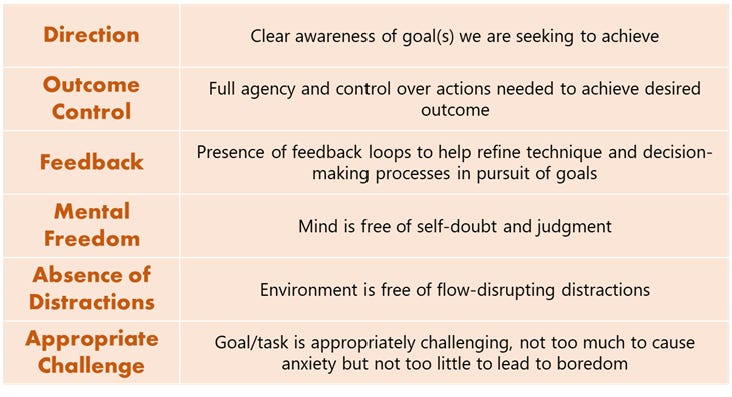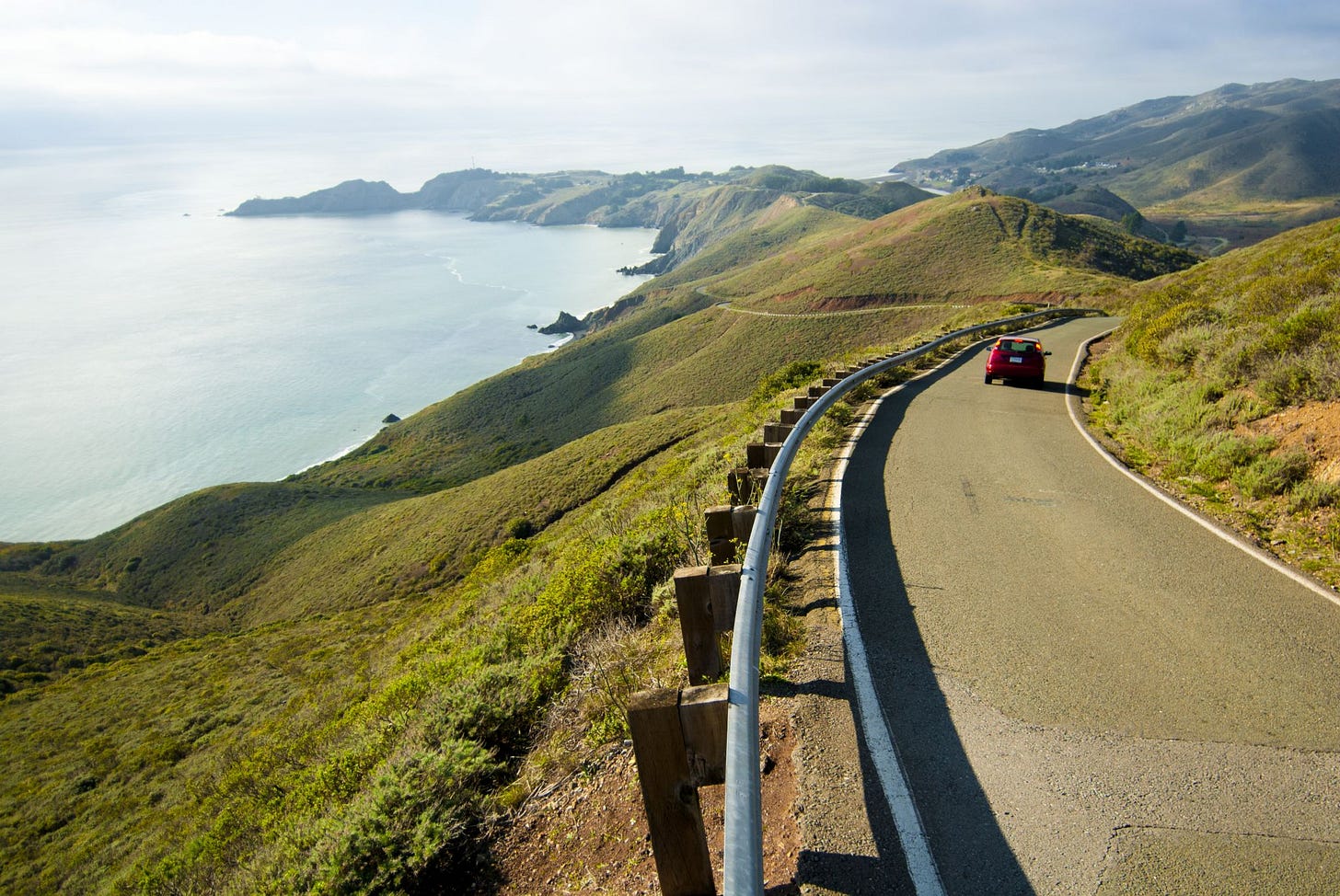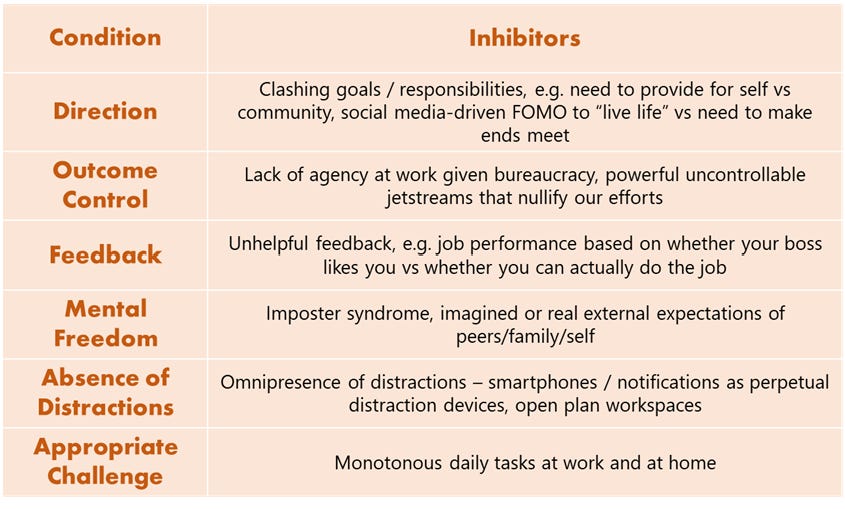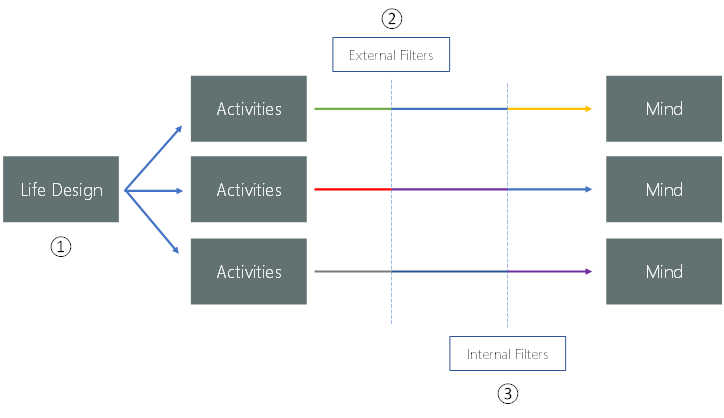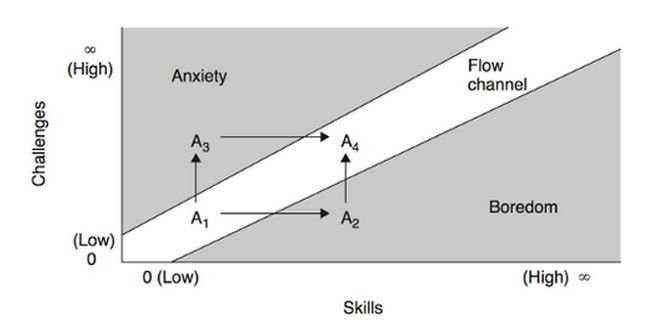Flow, Part 3
I've developed a little bit of an obsession with thinking about flow. In the short 2+ months I've been writing this Substack, after today, I'll have written three posts about flow. I suspect that this obsession stems from finding that the literature and science on how to trigger flow is substantially more expansive than I expected coming into it, and the more that I've dug in, the more I've discovered there is to learn.
But perhaps most importantly, in developing a better understanding about flow states, I've found that I've been able to better trigger it more often in my own life - whether while working out, while working, or even as I write these Substack posts. Flow is incredibly addictive; there's a reason why so many people who have discovered their flow activity, whether surfing, music, extreme sports, and the like, keep coming back for more, sometimes even at the expense of other parts of their lives (or even at the expense of their entire lives). And as I've started to develop a basic toolkit for inducing flow, and having had the experience of flowing more often than I did before, I think I might be becoming one of those individuals…
Given I recently finished reading the seminal work of the father of flow, Mihaly Csikszentmihalyi, I thought it'd be a good time to synthesize my current thoughts on flow to build on my prior posts. I've found that these synthesis processes are essential parts of my learning process - too often I finish a book and excitedly move onto the next one, without much of an attempt to distill my learnings from the book, and I find myself quickly forgetting the takeaways. Synthesizing has allowed me to take ownership of the takeaways; by putting my thoughts and learnings into my own words, rather than taking learnings / takeaways at face value from the author, helps cement the takeaways far better and for far longer. Hopefully my self-serving synthesis can be helpful to you, too.
--
A quick refresher: A few weeks ago I did my first (semi) deep-dive into flow, where I touched on why flow was powerful (substantial increases in learning + productivity + happiness), the characteristics of the flow state (among others, intense focus, loss of self-awareness, time warping, challenge / skill balance), and how we might be able to find more flow in our lives (stacking our lives with more flowy activities, finding work that is flowy, and learning how to reframe mundane activities to find flow).
Since then, I've done a bit more reading since and have distilled for myself a better understanding of what flow is.
Flow is, at its core, immersive focus. When people describe being in flow, they often describe it as an out-of-body experience where time stands still. When free from all other distractions and negative thoughts, they are able to act freely and without constraints and self doubt. Athletes refer to it as being "in the zone", musicians refer to being "completely absorbed in their music", surfers refer to being "one with the ocean".
With all these descriptions of flow, there is one unifying theme - the mind is well-ordered and focused on one single task. The mind is fully immersed and there are no distractions, freeing the individual up to perform at his or her peak. It is when this sustained immersive focus is lost - when self-doubt and concerns about judgments from others creeps in, when tennis players get angered by a bad line call - that individuals fall out of flow. And it is at these moments that peak performance is lost, for then consciousness is concerned about far more than just the task at hand. Our attention is scattered, pulled in multiple directions by different thoughts.
Therefore, flow isn't just only about learning how to focus immersively. We also need to be able to focus immersively for sustained periods of time. I suspect that our biggest obstacle to our ability to flow often is not our ability to focus immersively - for it's something that we've all done before - but rather our ability to prevent ourselves from being broken out of flow by the distractions and concerns of day to day life.
Thus, our ability to flow is dependent on our ability to sustainably achieve immersive focus. But how can we better set ourselves up for success here? What are the keys to sustained immersive focus, and therefore, flow?
Ultimately, I think that the path to more flow is about ensuring that we set up the right conditions to both enter and not exit flow. The same activity can be very flowy for one person and be the last thing from a flowy experience from another. Let's look at what these conditions are:
Take the act of driving a car, for example. It has the potential to be a very flowy experience, but too often we lack one or more of the flow conditions above, leading to a less than enjoyable and flowy experience. Driving while still making a decision on where to go would lack flow because it lacks direction. We can't find flow in driving if we're a mere passenger as we lack control over the activity and outcome. Driving without GPS or road signs, which help determine whether we're getting to closer to our destination, wouldn't be an enjoyable activity either, as we lack feedback to know if we are getting closer to our goal or not. Driving with a backseat driver telling us his or her view of what a better route would be or who is judging our driving is distinctly un-flowy, for we lack the mental freedom to drive the way we want. Screaming children in the backseat might be one of the worst experiences, for the distraction of external stimuli breaks us out of any flow state we manage to achieve. And finally, routine, mundane drives and drives that are too challenging (up and down icy mountainous roads) are the furthest things from flowy, as they drive either boredom or anxiety from being not challenging enough or too challenging.
On the flip side, some of my best moments have been driving when I've lacked all of the flow inhibitors above. A few months ago I was driving to a colleague's seaside home, and remember that drive to be one of the flowier moments of my life.
Source: SFGate
I knew where I was headed (direction), I had full control over what I was doing (outcome control), my car's nav system was consistently telling me how much closer I was getting (feedback), I was alone both inside the car and on the roads and fully confident in my driving abilities (mental freedom), had zero distractions (absence of distractions), and was adequately challenged by the winding seaside roads with ocean views that inspired awe (adequate challenge). This all created an incredibly beautiful and blissful 45 minutes for myself that I'd love to replicate more often.
Flow is hard to achieve because of how seldom we find tasks that meet all the requirements simultaneously. There are too many inhibitors in the real world that stand in the way of attaining each of the conditions above, especially as we grow older and pick up more responsibilities, and as the world gets more complex:
With a better understanding of all of the flow inhibitors above, it is no wonder that flow is so elusive for so many of us. The list can be demoralizing, for it shows how difficult flow conditions are to achieve. Instead of giving up on finding flow, though - I believe that embracing and understanding the strongest and more frequented inhibitors to flow is our path to flow. Since knowing what to avoid helps us to learn how to avoid them. And it is only in learning how to avoid these inhibitors can we maximize our chances of getting into flow.
---
So, how do we set our lives up to avoid the pitfalls, and to maximize our chances at flow?
To understand flow is to understand how the mind works, since flow is a predominantly internal condition that happens within our minds. However, it would be foolish to think that understanding our minds would mean understanding flow, since our minds exist in a vacuum, and are predominantly concerned about the outside world. Thus, to understand flow, we must not only understand how our minds work, but also how our minds interact with the external world.
To me, the following model is how our minds interact with the external world, as it relates to flow:
First, our life designs dictate the activities that we engage in (1). As we do these activities, our experience of these activities are influenced by external filters, both within - e.g. listening to music to tone out conversations at work - and without - e.g. poor weather while playing golf - our control (2). Then, our experience gets further modified by a series of internal filters, like our state of focus, or our general mood that day (3). It is only after passing through all these filters that our mind actually experiences the activities we are partaking in.
It is this model that ascertains how an individual will experience the activities in their lives. Get the contents of this model right, like the amateur piano player immersed in the piece she is playing, and one can set up the right conditions for flow. Get it wrong, like the 12-year-old piano student practicing scales for the 150th time in a day, and one will fail in achieving flow, despite both individuals doing the exact same task.
This mental model above, combined with clearer awareness of the key inhibitors of flow, is how I think about the levers we can pull to enable flow experiences:
(A) Changing Our Life Designs - The first class of actions we can take to achieving flow would be to make changes, big and small, to our life designs. This can entail:
Building more flowy activities into our lives - Ultimately, not every activity has the same capability to induce flow. Certain ones, like sports, writing, playing music, performing surgery, feature far more of the characteristics of flow than others, like doing the dishes, walking to work, watching television, or doing administrative tasks at work. If we find ourselves in a world where the environment around us mandates un-flowy activities - be it work, leisure, or otherwise - we could take steps to modify this environment and life design to incorporate more flowy activities. Pursue a career that is flow-ier, or pepper leisure time with more flowy activities, while reducing un-flowy leisure activities, like watching TV. That being said, this can only be so useful of a recommendation, as changing our life designs is often unfeasible, or insufficient, to achieve flow. Unfeasible as any change, let alone wholesale life changes, is hard with all the responsibilities and hats we have to wear as we age. And insufficient, as so many will still fail to find flow even in the flowiest of activities - think about the ballet or skiing student forced to practice multiple time a week against their will.
Refining Goals / Direction - Too often we have goals or engage in activities that are clashing. We want to spend more time with our families but also work more hours to get a raise. Spend more time helping others, but also spend more time working on ourselves. Travel the world to experience life in the near-term, but also go heads down at work to build equity for the long term. When goals clash, our ability to fully immerse ourselves in the goals and activities they entail plummet, which impacts our ability to flow. However, since goals are easy to establish and accumulate, and crafting a group of goals that are symbiotic and cohesive is challenging, we often end up with counterproductive goals that inhibit our ability to flow while attempting to achieve any of them. Consistent reflection and prioritizing of goals is therefore essential in achieving flow.
Improving Control - As discussed above, a lack of control is a key inhibitor of flow. Obtaining more control is essential to dialing up the flow in an activity, and thus it is essential we set up the right filters or modifiers to enable this control. Look to instructions as guides, not rules to follow, as I've started to do with recipes and have managed to achieve more flow with cooking than I did before. Carve out a specialization or niche at work to call your own; ask for, or look for more agency at work. And if impossible to achieve, perhaps it's time to look for a job that gives you more control, should you desire to find flow in your work
(B) Working on External Filters - The second class of actions we can take to achieve flow would be to establish the right external filters that help to eliminate the inhibitors of flow. Really, this is all about one key filter:
Reduction of Distractions - One of the most important competencies we can develop to maximize flow is our ability to remove distractions in our surrounding environment. Since flow is all about immersive focus, any external stimuli that acts to take us away from flow are dangerous, as they disrupt an incredibly powerful process. Unfortunately for us, there are countless distractors in our external surroundings - packed offices with chatty colleagues, instant access to entertainment of all forms on the walking computing devices that are our cell phones, instant news alerts on our computers whenever anything of note (or often, even things not of note) - that directly disrupt our flow experiences. As I write this, I got a news alert about the Oscars and how Emma Stone gave a shoutout to Taylor Swift. Not that I don’t care at all about the Oscars, but do I really need to know in this instant that the shoutout occurred? Was it really worth being broken out of the flow I had achieved? Certainly not. To me, it is the inability to manage the plethora of distractions that is one of the most important pieces to developing flow. Turn off that phone or put it away. Turn off notifications for irrelevant news. Plug in those earbuds to block out unwanted conversations and distractions. Identifying and then eliminating these distractions will go a long way to enabling flow.
(C) Working on Internal Filters - The final class of actions is predominantly mental, that is, the internal filters that modify how our minds experience the external world. This includes:
Build a Better Relationship with Self-Doubt - Find ways to enable freedom of thought and action, without the shackles of self-doubt. Train the mind to recognize and live with or reduce self-doubt. I've found meditation to be incredibly helpful to quiet the mind in moments where self-doubt could rear its ugly head to the detriment of performance. Additionally, a quote I remind myself of is one in The Inner Game of Tennis by Timothy Gallwey - "A rose is a rose from the time it is a seed to the time it dies. Within it, at all times, it contains its whole potential. It seems to be constantly in the process of change. Yet at each state, at each moment, it is perfectly all right as it is." Self-doubt is natural, for it is a natural part of upward progress. Doubt arises when we are unsure about whether something can be achieved; as we make progress, we attempt new and more challenging tasks and obstacles, and it is the novelty and increased challenge that causes doubt to naturally arise, as we haven't proven to ourselves that we can do them. However, knowing that failure is almost inevitable as we make upward progress, can help reduce the stress and self-doubt that arises from our fear of failure. The quote by Gallwey helps remind me that even in moments where I doubt my abilities and skills, even in moments that I fail, that it is all a natural part of the growth process. And this in turn helps me to better live with, or even eliminate, the self-doubt that so often gets in the way of my ability to flow.
Find the Appropriate Skill / Challenge Balance - Finally, we need to consistently toggle our activities to ensure that they meet the right balance of skills and challenge. I shared this diagram during my prior post on flow - but wanted to re-share it as an important reminder that we need to adjust our goals to match our skill levels. The last thing I should do is try to shoot a golf round of below 80 when I haven't broken 90 in my life - for that just creates anxiety that demoralizes me and prevents me from flowing at golf. Alternatively, I don't want my goal to be to shoot below 100, as I regularly shoot in the low 90s - that would create boredom. Setting and refining the right internal goals plays a big part in our ability to achieve flow - and it is only if we can consistently set goals that allow us to operate in the "flow channel" in the diagram below, that we can maximize our ability to achieve flow.
Source: Flow by Mihaly Csikszentmihalyi
--
That's it for this week. I got a little rushed towards the end as I didn't leave myself enough time this weekend to write and this post took longer to write than I had expected, but didn't want to let perfect be the enemy of the good. As always, please let me know if you have any thoughts or suggestions as you read my posts - would love to hear and engage with you on them!

